Emergency Preparedness Week 2024
Emergency Preparedness Week is May 5 to 11, 2024 and is a great time to learn about getting prepared for emergencies.
Using technology in emergency management
Technology plays a part in all our lives, in one way or another, which is why this year's theme for Emergency Preparedness Week is "Using technology before, during and after emergencies."
Technology is used in many ways to help us mitigate, prepare for, respond to and recover from emergencies. Examples include:
Register for our webinar
Join a 45-minute webinar on May 9 at 5:30 PM to learn how to prepare for emergencies, as well as some of the ways you can use technology to help.
All participants will be entered to win a 4-person emergency kit! Deadline to register for the webinar on Zoom is May 8 at 11:59 PM.
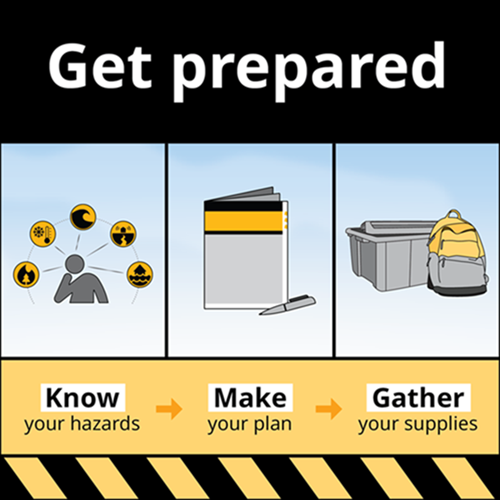
Know Your Hazards
Can you name some of the most common hazards in B.C.? Different hazards can happen in each area of the province, but all of them require having a plan and getting prepared. Here are some of the ones that can happen in our community.
✔️Floods
✔️Landslides
✔️Avalanches
✔️Disease outbreaks
✔️Earthquakes
✔️Wildfires
✔️Hazardous material spills
✔️Severe weather
Visit PreparedBC.ca/hazards to learn more.
Make a Plan
Your emergency plan should be as unique as you are. Visit Prepared BC to learn how to account for the needs of everyone in your home. Download the fill-in-the-blanks emergency plan and you’ll be done before you know it: PreparedBC.ca/emergencyplan
Gather Your Supplies
Your home emergency kit can help you stay healthy and safe if you have to shelter at home following events like a damaging earthquake or severe storm. Gather supplies, pack them in large containers or totes and store them in an easy-to-access location. Here's what you need:
✔️Non-perishable food: 3 days to 2 weeks' supply. Don't forget the manual can opener
✔️Water: four litres per person, per day for drinking and sanitation
✔️Phone charger and battery bank
✔️Radio, hand-crank or battery-powered
✔️Flashlight, hand-crank or battery powered
✔️Extra batteries
✔️First-aid kit and medications
✔️Toiletries and personal items, such as an extra pair of glasses or contact lenses
✔️Copy of your emergency plan and copies of important documents, such as insurance papers
✔️Garbage bags and moist towelettes for sanitation
✔️Seasonal clothing, sturdy footwear and emergency blanket
Visit Prepared BC to learn more: preparedbc.ca/emergencykit
Don’t forget your pets when preparing for a potential wildfire. Add their name, breed, vaccination history and a photo to your emergency plan. Check out the Prepared BC pet guide for more: Preparedbc.ca/emergencyplan#pets
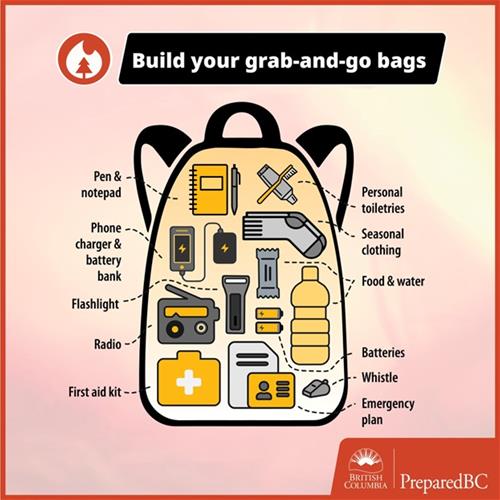
In the event of an emergency, you may be asked to evacuate your home with little notice. Have a grab-and-go bag prepared so you’ll have everything you need with you. Learn what to include and how to personalize a bag for everyone you live with: preparedbc.ca/grab-and-go

Before a Wildfire
The @PreparedBC Wildfire Preparedness Guide is a must-read for our community. Download it at preparedbc.ca/wildfires.
Making your home and property #FireSmart can help decrease the intensity and slow the spread of a #BCwildfire. Get started with the @BCFireSmart home assessment
Nearly half of all wildfires in B.C. are human-caused and therefore preventable. You can prevent them by following a few simple rules:
✔️ Check for bans and restrictions
✔️ Campfires can’t be larger than 0.5 metres high by 0.5 metres wide
✔️ Keep a shovel or 8L of water nearby to extinguish your fire
✔️ Create a fuel break around your fire
✔️ Never leave a campfire unattended!
✔️ Ensure your campfire is completely out and the ashes cool to touch before you leave
Call 1-800-663-5555 or *5555 on your cell if you spot smoke, flames or an unattended campfire. For safe camping guidelines in-park and backcountry, visit bcparks.ca.
During a Wildfire
Know the difference between an Evacuation Alert and Order if there’s risk of a #BCwildfire in your area.
Evacuation Alert: Be prepared to leave on short notice. Get your grab-and-go bags ready.
Evacuation Order: You are at risk. Leave the area immediately.
Wildfire smoke is harmful to everyone, even more so to vulnerable populations. Here are a few tips to keep yourself safe, cool, and healthy during smoky conditions:
✔️ Stay indoors and keep the air clean (windows/doors closed, no smoking, no burning fireplaces/candles/incense, no vacuuming)
✔️ When in a vehicle, keep windows closed with air conditioning set to recirculate
✔️ Reduce time spent outdoors and avoid vigorous outdoor activities
✔️ Visit places with a controlled air supply, such as shopping malls, swimming pools, or public libraries
✔️ Consult the air quality health index (AQHI) and learn how to use the AQHI to check air quality conditions in your community
After a Wildfire
Once officials determine a wildfire threat has passed, Evacuation Orders may be rescinded. Do not attempt to return home until the Evacuation Order for your area is lifted. Continue to stay tuned for other possible Evacuation Alerts or Orders.
It can be hard to know where to start after a wildfire. Before you return home, read Prepared BC's Wildfire Preparedness Guide. It will help prepare you for:
✔️ Safely re-enter your home
✔️ Clean and repair your home
✔️ Claim insurance
✔️ Take care of yourself both mentally and physically
Returning home after a wildfire? Follow these 5 gas and electrical safety tips from Technical Safety BC.
- Wait for instructions to enter your home
- Know the re-connection requirements
- Be appliance aware
- Use a licensed contractor
- If in doubt, get out
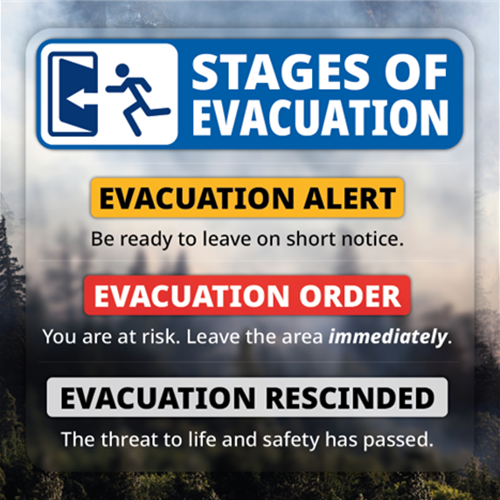
If you are under an Evacuation Alert, be ready to leave at a moment’s notice. Have grab-and-go bags packed for all members of your household, including pets, and remember to park your vehicle forward-facing in case you must evacuate quickly.
If you receive an Evacuation Order, keep yourself and your community safe by following it.
Choosing to remain in an area under Evacuation Order puts yourself, your loved ones, and first responders in danger. It’s not worth the risk.
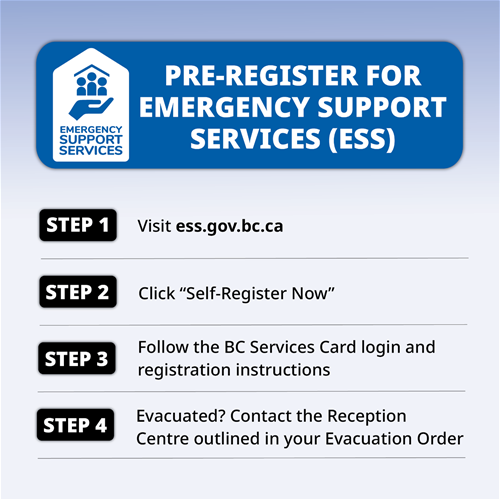
If Evacuation is required during an emergency, evacuees should follow all instructions and evacuate to a designated Emergency Support Services (ESS) Reception Centre. If you do not evacuate to a designated location, your access to some or all ESS supports may be impacted.
Pre-register for ESS before you need help. You may be eligible for Interac e-transfer when you log in to ESS with BC Services Card Login:
Step 1: Visit ess.gov.bc.ca
Step 2: Click “Self-Register Now”
Step 3: Follow the BC Services Card login and registration instructions
Step 4: Contact the Reception Centre outlined in your Evacuation Order to access supports, including e-transfer
An important emergency preparedness tip: know where you can turn to for support if you are evacuated from your home during to emergencies like wildfires, floods or tsunamis.
Emergency Support Services (ESS) provide lodging, food, clothing and other services for evacuees that need them most. Keep in mind that homeowner or tenant insurance may provide greater support than ESS if you have it.
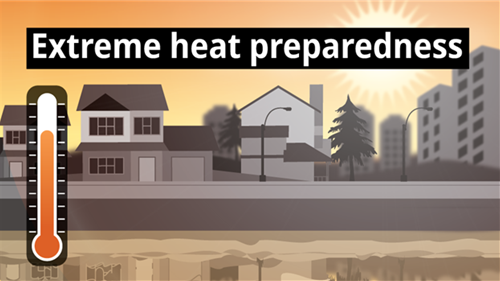
Before an Extreme Heat Event
Heat-related illness can happen when you aren't able to cool your home during extreme heat events. Plan ahead by identifying places in your community you can visit to get cool, such as libraries, shopping malls, or community cooling centres.
During heat warnings, it's important to check in on loved ones and neighbours (especially older adults) to make sure they're staying hydrated and spending time in cool spaces. If you live alone, have a buddy who can check in on you.
A few basic modifications to your home can make a big difference during periods of extreme heat:
• Install a window air conditioner in at least one room
• Install thermal curtains or window coverings
• Keep digital thermometers available to accurately measure indoor temperatures (31°C or higher is dangerous for vulnerable people)
• Have fans available to help move cooler air indoors during the late evening and early morning hours
• Install a heat pump
Learn more: preparedbc.ca/extremeheat
During an Extreme Heat Event
Too much heat can be harmful to your health. Heat-related illnesses such as heat cramps, heat exhaustion, or heat stroke, are the result of your body gaining heat faster than it can cool down.
Stay safe and cool indoors during extreme heat by taking the following steps:
• If you have air conditioning, turn it on. It does not need to be going full strength to help you stay safe.
• If you have air conditioning, and vulnerable friends and family do not, bring them to your home.
• If you do not have air conditioning, move to your pre-identified alternate location with air conditioning or cooler spaces
• Sleep in the coolest room of your residence, even if it’s not your bedroom. If it’s cooler outside, sleep outside when feasible.
• Sleep with a wet sheet or in a wet shirt.
• Take cold baths or showers to draw heat from your body.
• Drink plenty of water, regardless of whether you feel thirsty. Be aware that sugary or alcoholic drinks cause dehydration
• If you are taking medication or have a health condition, ask your doctor or pharmacist if it increases your health risk in the heat and follow their recommendation.
• If your doctor limits the amount you drink, or has you on water pills, ask how much you should drink while the weather is hot.
• Lower your activity level. If you must do errands, do them early or late in the day when it’s cooler.
• Never leave children or pets in a parked car.
• Avoid direct sun by staying in the shade and wearing a hat and protective clothing. Use sunscreen and UV-protective eyewear.
• Seek cooler, breezier areas when outdoors, such as large parks near to water with lots of trees.
• If you work in a hot environment, discuss and act on ways to decrease heat exposure with your employer and coworkers.
Learn more: preparedbc.ca/extremeheat #BCHeat
Introducing Voyent Alert!
The District of Summerland has partnered with Voyent Alert! to provide notifications and alerts throughout the community.
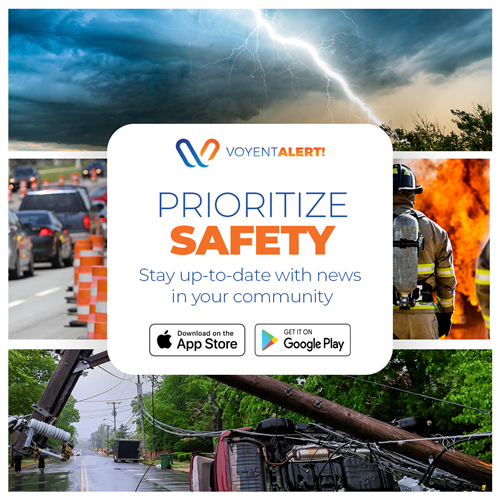
In times of crisis it is important that residents have access to trusted, timely and accurate information to ensure their own safety and that of their family and loved ones. In response to this need, the District of Summerland has chosen Voyent Alert! as the communication service provider for these kinds of events.
Receive notifications for critical events, wildfires, and flooding, as well as day-to-day communications such as garbage and recycling information, water and sewer notices, municipal facility updates and public engagement opportunities.
Sign up now for routine and emergency notifications or download the Voyent Alert! app.
Once you are registered, you are automatically signed up for emergency notifications. Please include your correct address to receive notifications relevant for you.

How to Register:
Registration for the service is FREE, simple and totally anonymous.
Get the Voyent Alert! app at the App Store or Google Play.
For email, text or phone notifications, get started here https://voyent-alert.com/ca/community/#registration.
What You Can Expect with Voyent Alert!
Personalized Communications: Voyent Alert! provides informative communications. Critical information such as the distance and direction from an incident, time of intercept and preferred evacuation routes from your followed locations are provided.
Follow Multiple Locations: Voyent Alert! allows you to create and follow multiple locations such as “Kids School” or “Mom’s House”. Any event or communication related to your followed locations will be forwarded to you along your preferred communication channel.
No Message Fatigue: Voyent Alert’s smart alerting capabilities ensure that you will only get notified when a communication is relevant to you or one of the locations you are following.
Communications Your Way: Receive alerts over a wide variety of communication channels including mobile apps, text/SMS alerting, email or voice calling You can register for all or one of them.
Privacy is Paramount: Registration is anonymous, and no information volunteered or derived is shared or used for marketing or data harvesting purposes. Locational information from your followed locations is only used to determine its proximity to an alert event and to provide critical context within the communications (such as distance and direction).
Leaving is Easy: Both mobile applications and web-based accounts provide access to an unsubscribe feature accessed via the menu icon on the top right of the screen/page. If the service isn’t working out simply click on the “Unsubscribe” button and you won’t be hearing from us again.
For more information, please visit https://voyent-alert.com/us/community/